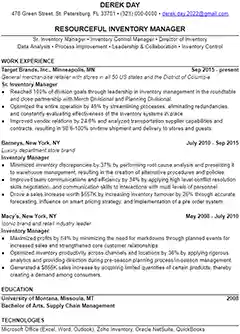Inventory Manager Resume Example
Write an inventory manager resume that lands you more interviews and job offers with this step-by-step guide by Leet Resumes.


How to Write an Inventory Manager Resume that Gets Interviews
You can juggle thousands of ASNs, forecast supply and demand and manage a million moving parts of logistics to keep your inventory coming and going with accuracy. It’s no paper-pushing job, but it’s great if you always like a new problem to solve every day.
Despite your ability to multi-task and keep operations running smoothly and efficiently, focusing on a single resume to land an interview is surprisingly difficult.
Fortunately, you’ve landed in the right place.
We’ve created a resume template and guide to walk you through the process of writing an inventory manager resume that delivers.
Follow along to learn what to include, how to make your resume stand out from the competition and how to tailor your resume to receive more interview requests.
Prefer to have someone else write your inventory manager resume?
If you’d rather stick to the drop-downs of your ERP, let Leet Resumes do the creative writing for you. They’ll write a custom inventory manager resume, and they’ll do it for free. (Tips are always appreciated.)
If you’re ready to write your own resume, let’s get started!
An Inventory Manager Resume Checklist
As someone who appreciates a good checklist and SOP, here’s a high-level overview of the five sections to include in your resume:
- Professional Headline
- Professional Summary
- Work Experience
- Education
- Keywords
Instead of lengthy paragraphs to fill these sections, you’ll use lists, short phrases and bullet points to fill each section. Easy, right?
As for the format of your resume, keep it simple. There’s no need to distract your recruiter with fancy columns, colors and fonts. The straightforward single-column structure you see in the resume example is all you need to land an interview.
Name + Contact
Start by typing your first and last name at the top center of the page. Choose a font that’s professional and legible, then make it slightly larger than the rest of the text.
As with any packing slip, make it simple and clear how to contact you by adding your phone number, email address and location directly underneath.
Your full mailing address isn’t required (it’s not an actual packing slip). Just your city and state will let them know you’re in the area and can show up at the warehouse reliably.
As for your email address, make sure it’s professional. There’s no need to divulge your weekend hobby or favorite movie through a random email address. When in doubt, the simple firstname_lastname approach always works.
Professional Headline
If your resume were an advertisement, your headline would be the captivating tagline at the top selling your expertise with the most fascinating facts of your career in inventory management. The goal of your resume’s headline is the same: capture their attention quickly so they keep reading.
First, choose a slightly flattering adjective that puts you and your work in a positive light. Something like thorough, detail-oriented, dependable, cost-effective, methodical or proficient works well for inventory management.
Then add a word to describe your level of experience: entry-level, assistant, junior, lead, head, etc.
Finally, add your official job title: Inventory Manager.
Now your professional headline should sound something like: Methodical Senior Inventory Manager.
Professional Summary
Here, you’ll list the reasons why you’re the best candidate for the recruiter’s open position. These lists are highly-targeted toward the inventory management position you’re applying for. (Think: direct store delivery rather than the retailer distribution network.)
As you’ll see in the resume example above, your summary consists of four lines of lists – no paragraphs. You wouldn’t add context and sentences to a BOM, so don’t do it here either.
In the first line, list the job titles you’d accept for your next position.
This might include adjacent roles you may not have held yet like Merchandising and Inventory Control Manager or Warehouse Manager. Most importantly, include the exact job title for the position you’re applying for to highlight your relevance to the open position.
In the second line, list the specific skills and attributes you’d apply to this role.
Customize this limited selection to highlight the skills you have that match the job description in the original job listing. This might include a specific certification that’s required for the role (HACCP Certification, APICS Certification, CPIM, etc.), or tasks they’ve outlined as expectations of their new inventory manager. Whatever can’t fit here can be included in the keywords section of your resume template.
The final two lines are completely optional. If you’re struggling to find content to fill them, don’t worry. The first two lines of your summary are enough to get an interview.
If you have the content, add your career achievements and highlights in line three and your awards and promotions in line four.
Need a break?
Stay on the master production schedule without any of the work. Let Leet Resumes write your custom inventory manager resume for you…for free. (Tips are always appreciated.)
Work Experience
You know the ins and outs of managing inventory, but your recruiter might not. Quite frankly, they don’t really want to know the details of ASNs, allocations, the jackpot line, or the EDI.
They’re looking for an expert in inventory management to streamline their operations, cut waste and grow their bottom line, so writing out your daily tasks is like reading a manual for inventory management. (And nobody wants to do that.)
Instead, use this section of your resume template to highlight the results of the work you do. Show how your inventory management adds to the company’s bottom line, like this:
List your previous work experience in reverse chronological order. Referring to the format in the resume example, add the exact job title you held, the dates of your employment and the name of your previous employer.
Under each position, add a bulleted list of your achievements (and contributions to the company as a whole) while in that role.
The best format for each bullet point includes a strong success verb and as much measurable data as possible (i.e. numbers).
Success verbs are actions that imply the positive result before mentioning any details. Start every bullet point with one of these verbs, and your work experience will read like an all-star highlight reel in Industry Week.
Numbers give a clear visual to your potential recruiter of the impact you make for a company. Focus on the results you bring rather than the tasks you complete, and your resume will deliver.
Here are some examples of strong success verbs to start each bullet point and the kinds of numbers you can include with them:
- Reduced: intake time; backorders; ERP discrepancies; exceptions; process waste
- Negotiated: materials cost; cost-effective deals with suppliers
- Accelerated: shipment intake; fulfillment; inventory turn
- Boosted: SKU accuracy; warehouse efficiency; revenue
- Optimized: inventory control procedures; warehouse workflow
- Outperformed: company leadership goals; delivery estimates
Take a look at the resume example to see these verbs and numbers in action.
Once you have a converting list of success verbs and measurable results, add in every promotion you’ve received.
Promotions highlight your success from a different angle. They show a potential employer that the work you do has benefited a company so much as to give you more responsibility and reward your work. That’s powerful social proof that you’re a candidate worth hiring.
Education
The education section of your resume template doesn’t need to be as thorough or in-depth as your work experience. In fact, keeping it brief keeps the focus on your work, so stick to the basics with these four items to describe your educational background:
- Where you attended school
- Dates of your attendance
- Degree(s) obtained
- Honors or awards received
Since inventory management isn’t high on the extracurricular list, you can leave all activities out completely. As for unfinished degrees, they should only be included if you’re actively pursuing them, otherwise, save the space for the content that delivers results.
Inventory Manager Keywords for Your Resume
There’s a lot that goes into holistic inventory management: from the interpersonal skills that inspire your team to carry out your SOPs, to the mathematical skills required to calculate capacity, logistics and reorders and everything in between.
Use this space of your resume template to highlight the most relevant skills and keywords for the job you’re applying for. Here are a few resume examples to get you started:
Interpersonal/Soft Skills:
- Excellent written and verbal communication
- Collaboration
- Leadership
- Team-Oriented
- Detail-Oriented
- Time Management
Technical Skills, Capabilities and Specific Task Experience:
- Excess and Obsolete policy
- Performance Reviews
- ABC Stratification
- Forecasting
- Budgeting
Technologies and Software:
- ERP
- Microsoft Office 365
- MRP
Certifications:
- APICS Certification: ASCM, CPIM, CSCP
- CIME
- HACCP
With a blend of hyper-relevant keywords for your potential employer, your resume template is complete! Well done.
Skip the writing. Have Leet Resumes write your resume for you.
Let the experts behind this resume template and guide write your resume for absolutely free (seriously!). Tips for a job well done are always appreciated.










